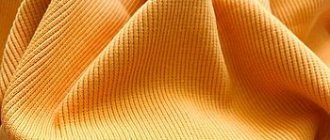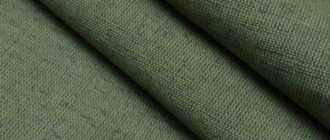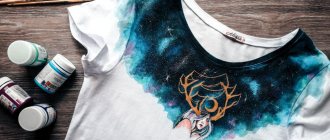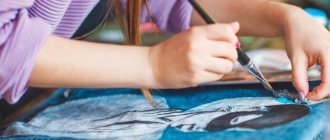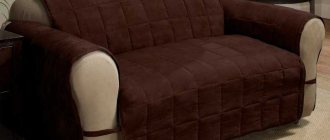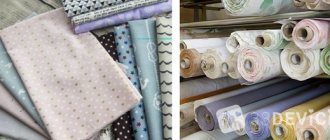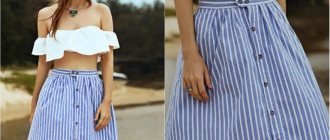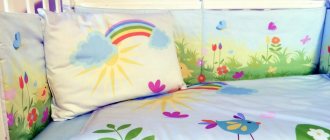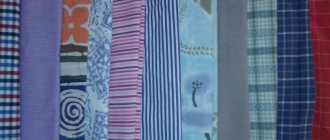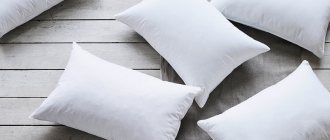Sublimation printing
Sublimation printing on fabric is a type of full-color printing used on synthetic and semi-synthetic fabric. It is distinguished by its realistic and durable image.
Photo: Shutterstock.com
Technology
During the printing process, a design is applied to sublimation paper using a plotter, after which, under the influence of high temperatures of 180-200 ° C, the ink is converted into steam and penetrates deep into the structure of the material. The technology allows you to obtain highly detailed pictures and bright colors that are resistant to environmental influences and repeated washing.
Application
Sublimation photo printing is widely used in advertising - applying inscriptions, images, company logos to exhibition stands, banners, advertising tablecloths, umbrellas, corporate clothing, souvenirs. This technology is also used for interior design, production of theatrical scenery, curtains, and costumes.
Advantages and disadvantages
This type of fabric printing has many advantages compared to other methods:
- Realism of the image – high quality of the drawing, comparable to a photograph made on paper.
- Wear resistance - the print retains its original appearance for a long time - does not change color, does not fade, and is not susceptible to cleaning agents.
- Large format printing – the ability to produce products of any size with high image clarity without limitation in the number of shades.
The disadvantage of sublimation printing can be considered the possibility of applying it exclusively to synthetic fabric or material with a slight admixture of natural fibers.
Examples of sublimation printing on video.
Methods of applying acrylic paints
There are several ways to draw on fabric or clothing. The method of painting with paints depends on the tool used, on what paints the drawing will be applied with:
- Drawing with a brush.
- Screen or template printing using special rollers or various foam pads.
- Creation of an acrylic relief contour in combination with painting with brushes.
You can easily learn how to draw amazing and unique beauty using acrylic painting. From ancient times to the present day, the beauty of this fascinating creative process is finding more and more fans. If you try to create such a handmade miracle yourself, then it will be impossible to stop, the process of creating masterpieces of painting with your own hands is so addictive and captivating.
Master classes on painting clothes (2 videos)
Ideas for painting on fabric (20 photos)
We recommend reading:
7 basic techniques for painting with watercolors, acrylics, gouache
We create masterpieces with stained glass paints
Face Painting Basics
Oil Painting Basics
Finger painting for little ones
Painting on stones: all the secrets of painting for beginners
Silk screen (analog) printing
Silk-screen printing (silk-screen printing) is a method of printing on fabric using stencils. An inexpensive type of printing used for the production of large quantities of textile products.
Technology
A stencil is a mesh fabric with a pattern that must be transferred to the fabric. The stencil is placed on the surface to be painted and paint is applied on top of it. The pattern settles on the fabric through the holes and dries quickly, after which it remains resistant to fading and color fading.
Application
The stencil application technique is suitable for printing logos, fonts, vector designs, and can be used on any fabric - from coarse material for banners, bags, backpacks to thin cotton and linen. Most often used in the production of text advertising banners, signs, corporate clothing, club sports and work uniforms.
Advantages and disadvantages
The advantages of silk screen printing include:
- Low cost for large quantities of products with identical images.
- Environmental resistance.
- Possibility of printing on natural fabrics.
The disadvantage of the technology is the limited number of shades used. As a rule, no more than 6 colors are used within one stencil.
Batik: painting technique on fabric
Story
The word "batik" means "wax painting". Technology as we know it has its roots in Indonesian culture. It was on the island of Java that she experienced her heyday. It could take months to create one painting. Painting was a labor-intensive and expensive task, so things painted using the batik technique were the subject of the aristocracy. In Indonesia, painted fabrics are still highly valued, but now the Java craft has become a universal property and items made using the batik technique are popular all over the world.
@chernysheva_art @alevtina_exclusive
What is batik
Batik can be called both a craft and an art at the same time. This is a special technique of drawing on fabric using reserve compounds. Plain fabric is stretched onto a wooden frame and painted according to a previously prepared design. This is quite a delicate and painstaking work, although you don’t have to be an artist to master this skill.
@artflat777 @hotbatik
Varieties of batik
Hot
The hot batik technique is usually used for coarse fabrics. The reserve composition in this case consists of wax or paraffin and is applied to the fabric while hot; after the design is ready, the reserve composition is removed. Hot batik involves multi-layer painting of the fabric, so the images are more blurry and do not have clearly drawn boundaries.
@chegolanna @pavel_gubanov84
Cold
Cold batik is the most common way of painting silk. Unlike hot, the reserve composition is not heated before application. Before painting begins, the boundaries of the drawing are outlined with a reserve compound, which can be purchased at an art store. This technique is considered most suitable for beginners and is somewhat reminiscent of children's coloring books. Painting fabric using the cold technique requires much less materials and additional equipment.
@golandart (1,2)
Batik in the interior
Painted fabric is often used in home interiors. Unusual and interesting patterns, funny drawings or full-fledged paintings will add freshness to any apartment. The batik technique is also often used to paint bedspreads or bed linen.
@razinabatik @dream_bq
Batik in the wardrobe
This technique can be used not only for decorating your apartment. In addition to panels or bedspreads, you can paint stoles and other wardrobe items. Silk blouses with unusual patterns or even children's T-shirts with simple designs are very popular.
@kovtun.silk @olga_laurus
Learning the cold batik technique
Since this technique is best suited for starting to master painting, we will focus on cold batik.
What you will need
Almost all batik materials can be easily purchased at an art store.
@ya_hudozhnyk_if
- Textile. Traditionally, natural fabrics are used for cold batik because special dyes do not adhere well to artificial materials. Silk is best.
- Frame. The ideal option would be a sliding one, since such a frame is more convenient to adjust to the size of the canvas.
- Brushes. It is better to select brushes for batik in an art store. There they can tell you which tool is best suited.
- Paints. Batik paints can also be found at an art store. To begin with, you can get by with the simplest sets
- Reserve. You can either prepare the reserve yourself or buy it ready-made.
- Tubes for applying reserve. The tubes can be purchased at a specialty store. But often the reserve is sold in a container with an elongated spout; many craftsmen immediately apply it to the fabric
- Paper drawing. Before you start, decide what image you will apply to the fabric, make a paper sketch to the size of your canvas
- Push pins to secure the fabric to the frame
What you need to know
Before you begin to study the technique in practice, you first need to learn several important nuances of painting on fabric.
- The fabric should be tightly secured to the frame. If the canvas moves or ripples, the outline will be poor and the paint may bleed.
- Before you start filling the outline, you should try the material on a piece of fabric.
- Before you take up paint, you need to check the contour for integrity and make sure that it is closed. To do this, gently blot the area with a sponge moistened with water and a drop of shampoo. If water does not flow out, then the contour is applied well.
- Contour lines should not be too thick
How to make batik
Fabric preparation
Before work, you need to thoroughly rinse the fabric in warm water and get rid of chemicals.
Prepare the frame
While the fabric is drying, prepare the frame. Cover the frame with masking tape before stretching the canvas.
Beginning of work
After the fabric is completely dry, stretch the fabric over the frame and secure it with pushpins. To pull the fabric tightly, first secure it with four snaps, one on each side. Next, you can fasten the fabric along the entire frame.
Draw a sketch on the fabric
Place a pre-prepared design under the fabric and transfer it with a simple soft pencil onto the fabric like a stencil.
@shelkovica_silk
Apply reserve
Carefully apply the reserve along the outline of your sketch. To do this, put the reserve into a special glass tube and smoothly move it along the contour of the pattern. It is important to ensure that the line is not interrupted. It’s up to you to draw with a special device or buy a reserve with an applicator.
@shelkovica_silk @ekaterina_ilmenskaya
Apply paint
After the reserve has dried, you can begin applying paint. To make the paint easier to apply, you can moisten the area with water.
@shelkovica_silk @rt_alter_ego
Shutdown
Now that the paint has dried, you need to remove the product from the frame and carefully iron it on the back side with an iron at a temperature suitable for the fabric. After this, we leave the product for about a day and hand wash it in a soapy solution. All that remains is to process the edges of the canvas and the work is finished.
Processing silk scarf sections
For a better understanding of the technique, we have selected several master classes for you.
Master Class. Cold batik:
Cold batik. Canvas painting:
Having mastered cold batik, you can not limit yourself to just drawing on canvases. You can paint your own dresses or blouses.
Direct printing on fabric
Direct digital printing allows you to apply prints of any complexity directly onto fabric. The technique is convenient for fulfilling orders from 1 product, compared to silk-screen printing, which is advantageous to use for runs of 50 units or more. You can order the design on fabric made of cotton or synthetic fibers.
Technology
Direct printing on textiles is carried out on the principle of an inkjet printer using dyes based on metal oxides, which are reliably held on the surface of the fabric. The technology provides high image detail at low cost and the ability to make changes to the layout from copy to copy.
Application
The method is used for printing logos, inscriptions, images of any complexity on T-shirts, raglans and other textiles.
Advantages and disadvantages
The advantages of direct printing include:
- Get clear, full-color images.
- Wear resistance of the pattern is up to 50-60 washes.
- Possibility of printing on natural fabrics.
The disadvantage of this method is the relatively low baking speed, suitable for the manufacture of small batches of products.
Screen printing
When choosing methods for applying prints to fabric, pay attention to silk-screen printing. For screen printing, special meshes are used. Through the base of the forms, the ink flows onto the printed surface. A stencil is created for each color separately.
Among the features of the method are:
- Processing of natural, synthetic and mixed fabrics.
- Application of paint types suitable for dark and light materials.
- Use of various special effects.
- Creation of single-color and full-color designs on fabric.
Silk-screen printing can be used for any number of T-shirts and other products, but the recommended circulation number is from 200 units. The larger the batch, the cheaper the print comes out
Advantages of silk screen printing:
- Good application speed.
- Low cost.
- Resistance of designs to frequent washing.
The application of the logo to the fabric is preceded by preparation, which takes up most of the time for making prints. The operator needs not only to prepare the mold, but also to set up the machine.
Tips for choosing the best type of printing
When choosing the optimal printing method, consider the pros and cons of each of them, and also take into account the advice of fashionprint.ru experts.
- For large format printing on fabric, the sublimation method is best suited.
- Silk screen technology has high productivity and will be optimal for large quantities of products.
- Direct printing allows you to obtain high-quality images with a wide color range on both synthetic and natural fabrics.
As an advertisement
